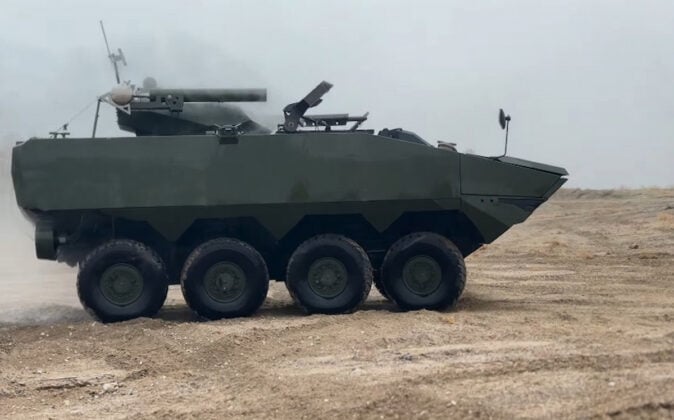
Kazakhstan Paramount Engineering and WSE LLP, part of the Barys Dynamics group, conducted a full-scale demonstration of the new “Terrex – Barys A” amphibious armored vehicle on November 14, 2025, showcasing its firepower, mobility, and domestic weapons integration.
The live demonstration took place at the Bereg training center on the banks of the Ili River and was attended by representatives from all of Kazakhstan’s security and defense agencies. The event highlighted the launch capabilities of a domestically integrated loitering munition, combined with the Kazakh-built “Ansar” remote combat module.
The Terrex – Barys A is described as a new-generation amphibious armored vehicle designed for diverse operational environments and varying conflict intensity levels. According to Kazakhstan Paramount Engineering, the platform is “a multifunctional system capable of performing missions across a broad range of terrain and threat levels.”
Engineers emphasized several design features aimed at maximizing battlefield survivability. The vehicle features a dual V-shaped “V-over-V” hull, which provides protection against mines and improvised explosive devices. The manufacturer says the Terrex – Barys A can withstand explosions equivalent to 10 kilograms of TNT detonated beneath the hull.
In terms of ballistic protection, the hull meets the STANAG 4569 Level 4 standard and can be upgraded to Level 5 with additional armor kits.
A key feature of the Terrex – Barys A is its full amphibious capability. The vehicle’s hull is engineered for water stability under moderate wind and current conditions, and propulsion is provided by two water jets. The company says the system can sustain movement in water at speeds above 11 km/h and cross large rivers without prior preparation. The design enables the vehicle to operate in wind speeds of 3–5 meters per second and wave heights up to 0.6 meters.
According to WSE LLP, the Ansar combat module installed on the Terrex – Barys A includes a 30mm 2A72 automatic cannon, a 7.62mm coaxial machine gun, an automatic grenade launcher, an anti-tank guided missile system, and a loitering UAV with strike capability. The system also includes a prospective laser weapon under development.
A key feature of the Ansar module is the fire control system. WSE stated that “the innovative fire-control system allows the operator to control several weapon types simultaneously within a single interface.”
During the demonstration, a loitering munition (kamikaze drone) was launched from the vehicle in a live-fire test. According to WSE, the munition has a strike range of up to 140 kilometers and carries a warhead weighing more than 7 kilograms.
It is designed to engage stationary, mobile, and fortified targets, and includes an electro-optical system for real-time reconnaissance. The company says the integration of reconnaissance and strike functions within one system improves situational awareness and battlefield decision-making for ground units.